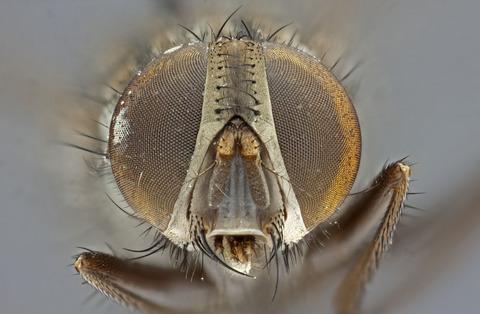当前位置:
X-MOL 学术
›
J. Evol. Biol.
›
论文详情
Our official English website, www.x-mol.net, welcomes your
feedback! (Note: you will need to create a separate account there.)
Evidence for rapid downward fecundity selection in an ectoparasite (Philornis downsi ) with earlier host mortality in Darwin’s finches
Journal of Evolutionary Biology ( IF 2.1 ) Pub Date : 2020-02-07 , DOI: 10.1111/jeb.13588 Lauren K Common 1 , Jody A O'Connor 1, 2 , Rachael Y Dudaniec 3 , Katharina J Peters 1 , Sonia Kleindorfer 1, 4
Journal of Evolutionary Biology ( IF 2.1 ) Pub Date : 2020-02-07 , DOI: 10.1111/jeb.13588 Lauren K Common 1 , Jody A O'Connor 1, 2 , Rachael Y Dudaniec 3 , Katharina J Peters 1 , Sonia Kleindorfer 1, 4
Affiliation

|
Fecundity selection is a critical component of fitness and a major driver of adaptive evolution. Trade‐offs between parasite mortality and host resources are likely to impose a selection pressure on parasite fecundity, but this is little studied in natural systems. The ‘fecundity advantage hypothesis’ predicts female‐biased sexual size dimorphism whereby larger females produce more offspring. Parasitic insects are useful for exploring the interplay between host resource availability and parasite fecundity, because female body size is a reliable proxy for fecundity in insects. Here we explore temporal changes in body size in the myiasis‐causing parasite Philornis downsi (Diptera: Muscidae) on the Galápagos Islands under conditions of earlier in‐nest host mortality. We aim to investigate the effects of decreasing host resources on parasite body size and fecundity. Across a 12‐year period, we observed a mean of c. 17% P. downsi mortality in host nests with 55 ± 6.2% host mortality and a trend of c. 66% higher host mortality throughout the study period. Using specimens from 116 Darwin's finch nests (Passeriformes: Thraupidae) and 114 traps, we found that over time, P. downsi pupae mass decreased by c. 32%, and male (c. 6%) and female adult size (c. 11%) decreased. Notably, females had c. 26% smaller abdomens in later years, and female abdomen size was correlated with number of eggs. Our findings imply natural selection for faster P. downsi pupation and consequently smaller body size and lower parasite fecundity in this newly evolving host–parasite system.
中文翻译:

达尔文雀中宿主死亡率较早的外寄生虫(Philornis downsi)快速向下繁殖力选择的证据
繁殖力选择是适应性的重要组成部分,也是适应性进化的主要驱动力。寄生虫死亡率和宿主资源之间的权衡可能会对寄生虫的繁殖力施加选择压力,但这在自然系统中的研究很少。“生育力优势假说”预测了偏向于雌性的性别大小二态性,即较大的雌性产生更多的后代。寄生昆虫可用于探索宿主资源可用性和寄生虫繁殖力之间的相互作用,因为雌性体型是昆虫繁殖力的可靠代表。在这里,我们探讨了在早期巢内宿主死亡的条件下,加拉帕戈斯群岛上引起蝇蛆病的寄生虫 Philornis downsi(双翅目:Muscidae)体型的时间变化。我们旨在研究减少宿主资源对寄生虫体型和繁殖力的影响。在 12 年期间,我们观察到 c 的平均值。宿主巢中 P. downsi 死亡率为 17%,宿主死亡率为 55 ± 6.2%,趋势为 c。在整个研究期间宿主死亡率高出 66%。使用来自 116 个达尔文雀巢(Passeriformes:Thraupidae)和 114 个陷阱的标本,我们发现随着时间的推移,P. downsi 蛹的质量减少了 c。32%,男性(约 6%)和女性成人尺寸(约 11%)减少。值得注意的是,女性有c。26%晚年腹部小,女性腹部大小与卵数相关。我们的研究结果表明,在这个新进化的宿主-寄生虫系统中,自然选择会加快 P. downsi 的化蛹速度,从而缩小体型并降低寄生虫的繁殖力。我们观察到 c 的平均值。宿主巢中 P. downsi 死亡率为 17%,宿主死亡率为 55 ± 6.2%,趋势为 c。在整个研究期间宿主死亡率高出 66%。使用来自 116 个达尔文雀巢(Passeriformes:Thraupidae)和 114 个陷阱的标本,我们发现随着时间的推移,P. downsi 蛹的质量减少了 c。32%,男性(约 6%)和女性成人尺寸(约 11%)减少。值得注意的是,女性有c。26%晚年腹部小,女性腹部大小与卵数相关。我们的研究结果表明,在这个新进化的宿主-寄生虫系统中,自然选择会加快 P. downsi 的化蛹速度,从而缩小体型并降低寄生虫的繁殖力。我们观察到 c 的平均值。宿主巢中 P. downsi 死亡率为 17%,宿主死亡率为 55 ± 6.2%,趋势为 c。在整个研究期间宿主死亡率高出 66%。使用来自 116 个达尔文雀巢(Passeriformes:Thraupidae)和 114 个陷阱的标本,我们发现随着时间的推移,P. downsi 蛹的质量减少了 c。32%,男性(约 6%)和女性成人尺寸(约 11%)减少。值得注意的是,女性有c。26%晚年腹部小,女性腹部大小与卵数相关。我们的研究结果表明,在这个新进化的宿主-寄生虫系统中,自然选择会加快 P. downsi 的化蛹速度,从而缩小体型并降低寄生虫的繁殖力。使用来自 116 个达尔文雀巢(Passeriformes:Thraupidae)和 114 个陷阱的标本,我们发现随着时间的推移,P. downsi 蛹的质量减少了 c。32%,男性(约 6%)和女性成人尺寸(约 11%)减少。值得注意的是,女性有c。26%晚年腹部小,女性腹部大小与卵数相关。我们的研究结果表明,在这个新进化的宿主-寄生虫系统中,自然选择会加快 P. downsi 的化蛹速度,从而缩小体型并降低寄生虫的繁殖力。使用来自 116 个达尔文雀巢(Passeriformes:Thraupidae)和 114 个陷阱的标本,我们发现随着时间的推移,P. downsi 蛹的质量减少了 c。32%,男性(约 6%)和女性成人尺寸(约 11%)减少。值得注意的是,女性有c。26%晚年腹部小,女性腹部大小与卵数相关。我们的研究结果表明,在这个新进化的宿主-寄生虫系统中,自然选择会加快 P. downsi 的化蛹速度,从而缩小体型并降低寄生虫的繁殖力。
更新日期:2020-02-07
中文翻译:

达尔文雀中宿主死亡率较早的外寄生虫(Philornis downsi)快速向下繁殖力选择的证据
繁殖力选择是适应性的重要组成部分,也是适应性进化的主要驱动力。寄生虫死亡率和宿主资源之间的权衡可能会对寄生虫的繁殖力施加选择压力,但这在自然系统中的研究很少。“生育力优势假说”预测了偏向于雌性的性别大小二态性,即较大的雌性产生更多的后代。寄生昆虫可用于探索宿主资源可用性和寄生虫繁殖力之间的相互作用,因为雌性体型是昆虫繁殖力的可靠代表。在这里,我们探讨了在早期巢内宿主死亡的条件下,加拉帕戈斯群岛上引起蝇蛆病的寄生虫 Philornis downsi(双翅目:Muscidae)体型的时间变化。我们旨在研究减少宿主资源对寄生虫体型和繁殖力的影响。在 12 年期间,我们观察到 c 的平均值。宿主巢中 P. downsi 死亡率为 17%,宿主死亡率为 55 ± 6.2%,趋势为 c。在整个研究期间宿主死亡率高出 66%。使用来自 116 个达尔文雀巢(Passeriformes:Thraupidae)和 114 个陷阱的标本,我们发现随着时间的推移,P. downsi 蛹的质量减少了 c。32%,男性(约 6%)和女性成人尺寸(约 11%)减少。值得注意的是,女性有c。26%晚年腹部小,女性腹部大小与卵数相关。我们的研究结果表明,在这个新进化的宿主-寄生虫系统中,自然选择会加快 P. downsi 的化蛹速度,从而缩小体型并降低寄生虫的繁殖力。我们观察到 c 的平均值。宿主巢中 P. downsi 死亡率为 17%,宿主死亡率为 55 ± 6.2%,趋势为 c。在整个研究期间宿主死亡率高出 66%。使用来自 116 个达尔文雀巢(Passeriformes:Thraupidae)和 114 个陷阱的标本,我们发现随着时间的推移,P. downsi 蛹的质量减少了 c。32%,男性(约 6%)和女性成人尺寸(约 11%)减少。值得注意的是,女性有c。26%晚年腹部小,女性腹部大小与卵数相关。我们的研究结果表明,在这个新进化的宿主-寄生虫系统中,自然选择会加快 P. downsi 的化蛹速度,从而缩小体型并降低寄生虫的繁殖力。我们观察到 c 的平均值。宿主巢中 P. downsi 死亡率为 17%,宿主死亡率为 55 ± 6.2%,趋势为 c。在整个研究期间宿主死亡率高出 66%。使用来自 116 个达尔文雀巢(Passeriformes:Thraupidae)和 114 个陷阱的标本,我们发现随着时间的推移,P. downsi 蛹的质量减少了 c。32%,男性(约 6%)和女性成人尺寸(约 11%)减少。值得注意的是,女性有c。26%晚年腹部小,女性腹部大小与卵数相关。我们的研究结果表明,在这个新进化的宿主-寄生虫系统中,自然选择会加快 P. downsi 的化蛹速度,从而缩小体型并降低寄生虫的繁殖力。使用来自 116 个达尔文雀巢(Passeriformes:Thraupidae)和 114 个陷阱的标本,我们发现随着时间的推移,P. downsi 蛹的质量减少了 c。32%,男性(约 6%)和女性成人尺寸(约 11%)减少。值得注意的是,女性有c。26%晚年腹部小,女性腹部大小与卵数相关。我们的研究结果表明,在这个新进化的宿主-寄生虫系统中,自然选择会加快 P. downsi 的化蛹速度,从而缩小体型并降低寄生虫的繁殖力。使用来自 116 个达尔文雀巢(Passeriformes:Thraupidae)和 114 个陷阱的标本,我们发现随着时间的推移,P. downsi 蛹的质量减少了 c。32%,男性(约 6%)和女性成人尺寸(约 11%)减少。值得注意的是,女性有c。26%晚年腹部小,女性腹部大小与卵数相关。我们的研究结果表明,在这个新进化的宿主-寄生虫系统中,自然选择会加快 P. downsi 的化蛹速度,从而缩小体型并降低寄生虫的繁殖力。









































 京公网安备 11010802027423号
京公网安备 11010802027423号